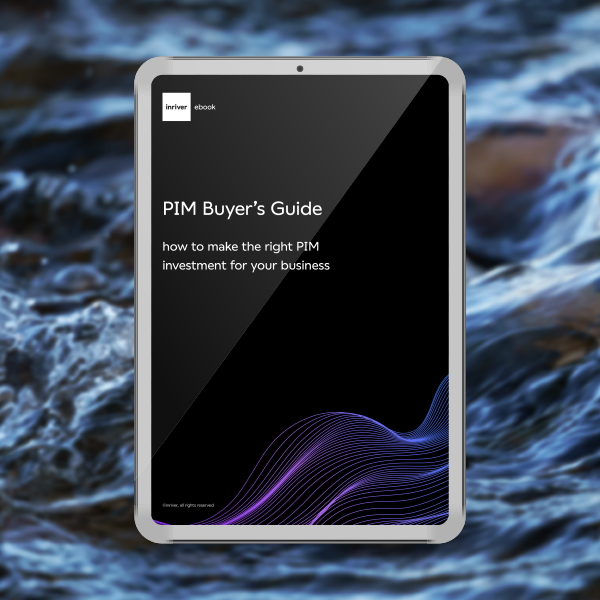What is a PIM system?
Software that engages and inspires
Product Information Management (PIM) software transforms raw product data into complete, compelling, and compliant product information.
A Product Information Management (PIM) system is a central platform for managing all product content and data across channels. However, while that might be the dictionary definition, today’s PIM solutions deliver far more than just a product database.
With the rise of digital commerce, tighter sustainability regulations, and growing expectations surrounding product experiences from both B2C and B2B consumers, implementing an advanced PIM system has evolved from a nice-to-have into a business-critical application.
But what is an advanced PIM system? What role does PIM play in forward-thinking business models? And where does PIM fit in with your company’s omnichannel strategy, whether that includes e-commerce websites, in-person stores, showrooms, or even after-sales repair and maintenance? This guide seeks to answer these questions.
What is a PIM system?
To understand PIM platforms, we first need to ask: What is PIM?
Product Information Management software, commonly referred to as PIM software, acts as a single source of data truth for product-related information. A PIM database serves as the foundation for consolidating, managing, and distributing product data efficiently across all channels. PIM software serves as a cross-departmental solution to onboard raw product data and then transform it into complete, compelling, and compliant product information for all external channels. This is also known as PIM data.
Inriver experts break down what Product Information Management is and how PIM software can revolutionize your business.
With product info consolidated in a single source of truth for all internal and external-facing workflows, PIM platforms eliminate internal data siloes and costly informational discrepancies wherever your products are—be it online, in the warehouse, or on a physical shelf.
PIM system: Key tasks, drivers & features
As mentioned, the modern PIM has evolved beyond a simple data repository. By adhering to PIM best practices, organizations can unlock the full potential of these systems. Let’s explore the key tasks, drivers, and features that define today’s PIM systems:
Product data governance
Central to a PIM system’s functionality is product data governance. This involves managing and maintaining high-quality, accurate product information throughout a product’s lifecycle. It ensures that the data is consistent, reliable, and easily accessible across the organization now and in the future.

PIM integration
The flexibility to integrate with other business-critical systems is another indispensable feature of the modern PIM. In fact, this is often one of the first steps to adopting a PIM tool inside your organization. By integrating PIM with other tech-stack essentials like CRM and ERP systems, you enable the circular flow of data that maximizes the value you get from having a PIM system in place.
Product data syndication
Product data syndication involves distributing product info across multiple channels and platforms, ensuring that consistent and accurate product information reaches the final consumer—wherever they engage with your products. This feature meets the expectations of even the most complex omnichannel marketing strategy as is essential to exceeding today’s consumer demands.
Digital Shelf Analytics (DSA)
While not every PIM on the market provides this advanced capability, Digital Shelf Analytics technology provides valuable insights into product performance on the digital shelf, such as:
- Underperforming products
- Out-of-stock items
- Inaccurate product information
- Search engine optimization (SEO) opportunities
This feature provides brands, manufacturers, and retailers with key visibility across all digital touchpoints—visibility that translates to immediate optimization, improvement, and growth.
Compliance management
Advanced PIM systems also ensure your product data maintains compliance with the latest industry regulations and sustainability requirements. They help manage and disseminate critical compliance-related information, such as safety standards, environmental impact, and regulatory guidelines. As sustainability standards become part and parcel of modern business, this layer of support is invaluable.

Digital Product Passport (DPP)
The EU’s Digital Product Passport initiative is slated for a fast-approaching 2026, introducing new regulation and data-based accountability layers.
PIM systems support the management of data needed to support Digital Product Passport compliance by providing transparent and traceable sustainability information throughout the product lifecycle. This can include:
- Material sourcing location and methods
- Details of the manufacturing process
- Product sale and after-care details
- Product end-of-life management
Internal collaboration
An advanced PIM system benefits an organization’s internal team as much as its customers and partners. When data siloes are broken, cross-departmental collaboration happens easily. When every person on every team references one single source of truth for product information, the entire company walks in lockstep—circulating dollars from wasted resources back into your bottom line.

SaaS PIM solutions vs on-premises PIM solutions
Today, PIM systems are primarily offered as either SaaS (Software as a Service) or on-premises solutions. However, there are considerable differences in the offerings between these two types of PIM system:
- SaaS PIM solutions are cloud-based and hosted by the PIM provider. This PIM-as-a-service model translates to faster PIM implementation, lower upfront costs, and less user maintenance. SaaS PIM software also scales easily as product catalogs and integrations grow.
- On-premises PIM solutions are installed locally, allowing the organization greater customization, control, and data security. This comes at the cost of a larger upfront investment, challenges in hardware and software compatibility, and the burden of handling updates and maintenance internally.
Ultimately, the needs of the organization dictate which deployment model makes more sense. While SaaS PIM solutions deliver greater agility, on-premise options may offer greater control.
PIM systems for manufacturing, e-commerce, and retail
In light of the growing demands for product information, a PIM system provides value for any medium to large-scale enterprise. For example, here is a breakdown of the business-critical implications of a PIM system for certain industries:
- Furniture: A PIM system is invaluable on multiple fronts in an industry where accurate product specifications are non-negotiable. For furniture brands, a PIM system allows you to guide customers through visual journeys of extensive catalogs with enriched imagery and detailed product descriptions, minimizing the chances of costly returns and enhancing customer satisfaction.
- Automotive: Juggling intricate parts information, compliance documents, and technical specifications, the automotive sector stands to improve overall accuracy and time-to-market for new models and parts with the help of PIM.
- Food and beverage: Fewer industries undergo more stringent regulations than food and beverage. A PIM system is essential for managing critical information tied to consumer safety, such as allergen warnings, ingredient lists, and food safety details.
- Electronics: Heavily dependent on rapidly evolving global supply chains and defined by the massive volumes of data supporting each SKU, the electronics market benefits from a PIM’s agility. Real-time monitoring of competitor pricing, granular insights into product specifications, and robust governance of technical data down to the attribute and component level are just a few benefits PIM brings to the electronics and appliance markets.
- Clothing and apparel: With heightened product experience expectations and typically vast product portfolios (both online and in-store) comprising seasonal collections, sizes, color options, and style updates, PIM systems are an invaluable tool for ensuring cross-channel consistency and positive customer buyer journeys.
Whether managing vast volumes of product data for complex machinery or expanding into new regions and languages, a PIM system provides a scalable product data platform that evolves alongside your business.

Benefits of advanced PIM systems
Leading enterprise-grade PIM solutions include advanced capabilities that further optimize product data management. This includes:
- Product Data Syndication (PDS): Syndication capabilities ensure accurate and consistent product information across all commerce platforms and marketplaces. With a unified digital image, brands can enhance their presence and earn more customer trust.
- Digital Shelf Analytics (DSA): A built-in DSA capability provides insights into how your products are performing on the digital shelf. DSA provides analytical insights to optimize a strong digital presence and omnichannel marketing strategy.
With PIM as the foundational source of data truth, brands, manufacturers, and retailers transform otherwise overwhelming amounts of product data into profit-driving solutions.
The role of PIM systems in digital transformations
The world is trending toward digital, but it’s not just B2C retailers that are making the change. All consumers crave a frictionless path to purchase—in-store or online, B2C or B2B.
Product information is at the cutting edge of this digital transformation. The ability to deliver consistent omnichannel product information (and therefore, product experiences) is integral to digital marketing success. In this way, PIM and e-commerce are intrinsically linked.
PIM is also crucial for the implementation of a successful omnichannel strategy. PIM enables brands to lay the digital foundation for personalized engagement across a wide variety of channels, from third-party-owned resellers to social commerce platforms and in-person retail outlets. Leveraging advanced analytics and intelligent content management/distribution, advanced PIM solutions help craft tailored experiences across all marketing channels.
With every channel operating in perfect sync, PIM ensures digital transformation is not just painless, but also profitable.

PIM system solutions
Traditional PIM systems are being reimagined to meet the needs of an ever-evolving market. Inriver is at the cutting edge of PIM innovations for today and tomorrow, delivering the features and capabilities organizations need to fulfill consumer demands, regulatory requirements, and the transition towards circularity:
- A unified approach: With extensive integration options and pre-built adaptors, Inriver’s fully composable PIM software connects to all major CRM, ERP, and DAM software and many more business-critical applications.
- The right data management capabilities: Offering a single source of product data truth is just the start of a PIM’s role in modern businesses. By integrating key capabilities like product data syndication and digital shelf analytics, Inriver’s advanced PIM system offers a comprehensive solution for brands and manufacturers to manage their digital assets effectively.
- Sustainability first: Get ready for the transition to circularity and stay ahead of incoming regulations with a PIM system built for a brighter future. The Inriver PIM delivers comprehensive sustainability insights ranging from material sourcing to the carbon footprint of supply chains.
With flexible SaaS deployment, Inriver meets enterprises where they are on their digital transformation journey.
Inriver: The new breed of PIM system
The way products are sold is evolving, and with it, so is the need for a more comprehensive Product Information Management system. As omnichannel expectations grow and customers demand more tailored product experiences, the need for a comprehensive PIM system has never been clearer. Add in the evolving regulations around data transparency and sustainability and only Inriver’s advanced PIM solution can help you get the most value from your product information today, tomorrow, and always.
Inriver’s composable PIM is the complete multi-tenant SaaS solution that turns product information into profit at every digital and in-person touchpoint. We offer the only platform on the market with built-in API-based syndication and digital shelf analytics technologies, giving you complete control over even the most complex omnichannel strategy. The Inriver PIM solution powers the entire product journey and across every touchpoint. From sourcing and production to selling and recycling, the Inriver PIM empowers you to deliver valuable product information to where it matters most.
Want to see the Inriver PIM in action?
Schedule a personalized, guided demo with an Inriver expert today to see how the Inriver PIM can get more value from your product information.
You may also like…
Frequently asked questions
What does a PIM system do?
A PIM system organizes product data into a central location to eliminate information silos. It enriches content, automates workflows, and publishes product information to any channel to create unified omnichannel experiences.
What is a PIM service?
PIM as a service provides product information management capabilities via a cloud-based, SaaS model. This avoids the large upfront costs and inflexibility of on-premise PIM solutions.
What is a PIM solution and how does it enhance customer experience?
A PIM solution is software that centralizes product data to distribute consistent, accurate, and personalized content across channels. PIM solutions enhance the customer experience by:
- Establishing omnichannel consistency
- Providing relevant product data
- Reducing informational errors
- Personalizing product data for different audience groups
How can PIM software improve product data quality and management?
PIM software centralizes product information into a single source of data truth. This makes it easier to manage, update, and ensure data accuracy and consistency.
How does a PIM system contribute to effective product catalog management?
Cloud-based PIM software allows brands, manufacturers, and retailers to efficiently manage large catalogs, customize content for different channels, automate syndication, and keep product data up-to-date across regions.
